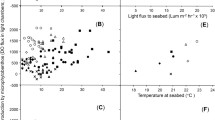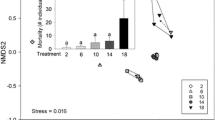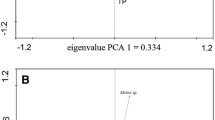Abstract
The outcome of experimental manipulations in ecology should depend on the duration of the experiment. We tested this proposition by examining the results of published trophic cascade experiments in freshwater communities and the results of our own previously unpublished pond experiment. In particular, we analyze the results of 90 published trophic cascade experiments to test the prediction that the outcome of freshwater trophic cascade experiments, in which zooplanktivorous fish are either present or absent, depends on the duration of the experiment. We present evidence that there are quantitative differences in the strength of trophic cascades among different venue types (enclosure, mesocosm, pond, and lake), but that the strength of trophic cascades does not diminish with increasing experiment duration. Despite the large number of studies, there have been few replicated studies of trophic cascades for longer than a summer field season, and none for the time required to estimate the long-term result of press perturbations. We therefore present the results of a 4-year study of trophic cascades in experimental ponds, to test the predictions that the addition of the top predator results in a sustained increase in the phytoplankton biomass. We found that, as predicted by our literature review, there was no decline in the strength of the trophic cascade as the experiment progressed.





Similar content being viewed by others
References
Attayde JL, Hansson L-A (2001) Press perturbation experiments and the indeterminacy of ecological interactions: effects of taxonomic resolution and experimental duration. Oikos 92:235–244
Bell T (2002) The ecological consequences of unpalatable prey: Phytoplankton response to nutrient and predator additions. Oikos 99:59–68
Bottrell HH, Duncan A, Gliwicz ZM, Grygierek E, Herzig A, Hillbright-Illowska A, Larsson P, Weglenska T (1976) A review of some problems in zooplankton production studies. Norw J Zool 24:419–456
Brett MT, Goldman CR (1996) A meta-analysis of the freshwater trophic cascade. Proc Natl Acad Sci USA 93:7723–7726
Burns CW (1968) The relationship between body size of filter-feeding Cladocera and the maximum size of particle ingested. Limnol Oceanogr 13:675–678
Carignan R, Planas D (1994) Recognition of nutrient and light limitation in turbid mixed layers: three approaches compared in the Paraná floodplain (Argentina). Limnol Oceanogr 39:580–596
Carpenter SR (1988) Transmission of variance through lake food webs. pp. 119–135. In: Carpenter SR (ed) Complex interactions in lake communities. Springer, Berlin Heidelberg New York
Carpenter SR (1996) Microcosm experiments have limited relevance for community and ecosystem ecology. Ecology 77:677–680
Coull BC, Chandler GT (1992) Pollution and meiofauna: Field, laboratory, and mesocosm studies. Oceanogr Mar Biol Annu Rev 30:191–271
Diehl S (1995) Direct and indirect effects of omnivory in a littoral lake community. Ecology 76:1727–1740
Downing JA, Rigler FH (eds) (1984) A manual on methods for the assessment of secondary productivity in fresh waters. Blackwell, Oxford
Downing JA, Osenberg CW, Sarnelle O (1999) Meta-analysis of marine nutrient-enrichment experiments: variation in the magnitude of nutrient limitation. Ecology 80:1157–1167
Drenner RW, Hambright KD (1999) Biomanipulation of fish assemblages as a lake restoration technique. Arch Hydrobiol 146:129–165
Ernest SKM, Brown JH (2001) Delayed compensation for missing keystone species by colonization. Science 292:101–104
Gophen M (1990) Biomanipulation: Retrospective and future development. Hydrobiologia 200/201:1–11
Gurevitch J, Morrow LL, Wallace A, Walsh JS (1992) A meta-analysis of competition in field experiments. Am Nat 140:539–572
Halaj J, Wise DH (2001) Terrestrial trophic cascades: how much do they trickle? Am Nat 157:262–281
Hall DJ, Cooper WE, Werner EE (1970) An experimental approach to the production dynamics and structure of freshwater animal communities. Limnol Oceanogr 15:839–928
Hansson, L-A, Annadotter H, Bergman E, Hamrin SF, Jeppesen E, Kairesalo T, Luokkanen E, Nilsson P-Å, Søndergaard M, Strand J (1998) Biomanipulation as an application of food-chain theory: constraints, synthesis, and recommendations for temperate lakes. Ecosystems 1:558–574
Hatfield T, Schluter D (1999) Ecological speciation in sticklebacks: Environment-dependent hybrid fitness. Evolution 53:866–873
Ives AP, Kareiva P, Perry R (1993) Response of a predator to variation in prey density at three hierarchical scales: lady beetles feeding on aphids. Ecology 74:1929–1938
Jeppessen E (1998) The structuring role of submerged macrophytes in lakes. Springer, Berlin Heidelberg New York
Lawton JH (1999) Are there general laws in ecology? Oikos 84:177–192
Lehman JT, Sandgren CD (1985) Species-specific rates of growth and grazing loss among freshwater algae. Limnol Oceanogr 30:34–46
Leibold MA (1989) Resource edibility and the effects of predators and productivity on the outcome of trophic interactions. Am Nat 134:922–949
Leibold MA, Chase JM, Shurin JB, Downing AL (1997) Species turnover and the regulation of trophic structure. Annu Rev Ecol Syst 28:467–494
Levin SA (1992) The problem of pattern and scale in ecology. Ecology 73:1943–1967
McCann KS, Hastings A, Strong DR (1998) Trophic cascades and trophic trickles in pelagic food webs. Proc R Soc Lond B 265:205–209
McCauley E, Downing J (1985) The prediction of cladoceran grazing rate spectra. Limnol Oceanogr 30:202–212
McQueen DJ (1998) Freshwater food web biomanipulation: A powerful tool for water quality improvement, but maintenance is required. Lakes Reservoirs Res Manage 3:83–94
Menge BA (1997) Detection of direct versus indirect effects: Were experiments long enough? Am Nat 149:801–823
Menge BA (2000) Top-down and bottom-up regulation in marine rocky intertidal habitats. J Exp Mar Biol Ecol 250:257–289
Oksanen L, Fretwell SD, Arruda J, Niemela P (1981) Exploitation ecosystems in gradients of primary productivity. Am Nat 118:240–261
Osenberg CW, Mittelbach GG (1996) The relative importance of resource limitation and predator limitation in food chains. In: Polis GA, Winemiller KO (eds) Food webs: integration of patterns and dynamics. Chapman and Hall, New York
Osenberg CW, Sarnelle O, Cooper SD (1997) Effect size in ecological experiments: the application of biological models in meta-analysis. Am Nat 150:798–812
Osenberg CW, Sarnelle O, Cooper SD, Holt RD (1999) Resolving ecological questions through meta-analysis: goals, metrics, and models. Ecology 80:1105–1117
Persson L (1999) Trophic cascades: Abiding heterogeneity and the trophic level concept at the end of the road. Oikos 85:385–397
Petersen JE, Cornwell JC, Kemp MW (1999) Implicit scaling in the design of experimental aquatic ecosystems. Oikos 85:3–18
Polis GA (1994) Food webs, trophic cascades and community structure. Aust J Ecol 19:121–136
Polis GA, Sears ALW, Huxel GR, Strong DR, Maron J (2000) When is a trophic cascade a trophic cascade? Trends Ecol Evol 15:473–475
Reynolds CS (1994) The ecological basis for the successful biomanipulation of aquatic communities. Arch Hydrobiol 130:1–33
Sarnelle O (1997) Daphnia effects on microzooplankton: Comparisons of enclosure and whole-lake responses. Ecology 78:913–928
Scheffer M (1998) Ecology of shallow lakes. Chapman and Hall, London
Schindler DW (1998) Replication versus realism: the need for ecosystem-scale experiments. Ecosystems 1:323–334
Schluter D (1993) Adaptive radiation in sticklebacks: size, shape, and habitat use efficiency. Ecology 74:699–709
Schmitz OJ, Hambäck PA, Beckerman AP (2000) Trophic cascades in terrestrial systems: A review of the effects of carnivore removals on plants. Am Nat 155:141–153
Shurin JB, Borer ET, Seabloom EW, Anderson K, Blanchette BB, Cooper SD, Halpern BS (2002) A cross-ecosystem comparison of the strength of trophic cascades. Ecol Lett 5:1–7
Skelly DK, Kiesecker JM (2001) Venue and outcome of ecological experiments: manipulations of larval anurans. Oikos 94: (198–208
Sokal RR, Rohlf, FJ (1995) Biometry. Freeman, New York
Solé RV, Manrubia SC, Benton M, Kauffman S, Bak P (1999) Criticality and scaling in evolutionary ecology. Trends Ecol Evol 14:156–160
Strong DR (1992) Are trophic cascades all wet? Differentiation and donor-control in speciose ecosystems. Ecology 73:747–754
Vamosi SM, Hatfield T, Schluter D (2001) A test of ecological selection against young-of-the-year hybrids of sympatric sticklebacks. J Fish Biol 57:109–121
Vanderploeg HA (1981) Seasonal particle-size selection by Diaptomus sicilis in offshore Lake Michigan. Can J Fish Aquat Sci 38:504–517
Wetzel RG, Likens GE (2000) Limnological analyses. Springer, Berlin Heidelberg New York
Yodzis P (1988) The indeterminacy of ecological interactions as perceived through perturbation experiments. Ecology 69:508–515
Zar JH (1999) Biostatistical analysis, 4th edn. Prentice Hall, Englewood Cliffs, NJ.
Acknowledgements
Thanks to D. Dolecki for collecting the plankton samples and for enumerating the zooplankton, and to numerous field assistants for collecting fish. A previous version of this manuscript was considerably improved by the comments of J. Richardson, D. Srivastava, the SOWD discussion group, O. Schmitz, C. Osenberg, and two anonymous reviewers. This work was supported by the Natural Sciences and Engineering Council of Canada.
Author information
Authors and Affiliations
Corresponding author
Appendix
Appendix
Table 1 shows a full list of publications from which data were taken
Rights and permissions
About this article
Cite this article
Bell, T., Neill, W.E. & Schluter, D. The effect of temporal scale on the outcome of trophic cascade experiments. Oecologia 134, 578–586 (2003). https://doi.org/10.1007/s00442-002-1135-x
Received:
Accepted:
Published:
Issue Date:
DOI: https://doi.org/10.1007/s00442-002-1135-x




